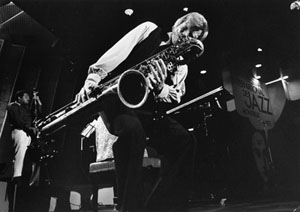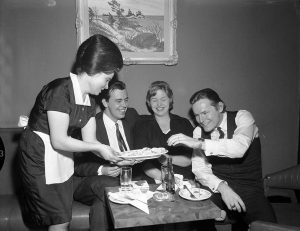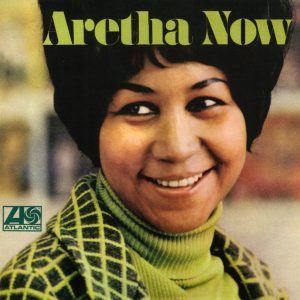We tend to cut and package eras of music into neat and discreet parts. That helps us understand more easily how things evolved, what the essence of each subcategory was and what it added to the whole.
It isn’t the reality, however. In the very good profile of Gerry Mulligan at the musician’s site, the unwritten theme is that musicians play across many lines. Indeed, they must in order to survive. Things change quickly and the distinctions between them only become apparent in hindsight. When it is happening, they must earn enough money to eat. That means not turning down a gig because it is the wrong form of bop.

Mulligan, who was born in New York City in 1927, had his first serious brush with the front line of the jazz world in the mid-1940s when he played at a concert in Philadelphia and was invited to participate in a subsequent jam session by none other than Charlie Parker.
Parker, of course, was one of the revolutionaries. Mulligan soon was immersed in a world featuring such greates as Gene Krupa, Charles Mingus, Thelonious Monk and Miles Davis, the bio says. These folks represent different types of jazz.
Mulligan was an arranger as well as a player. Perhaps is greatest accomplishment was his contribution to Davis’ “Birth of the Cool,” one of the most important records in jazz history:
The recording marked the beginning of a new direction in jazz: departing from straight bebop, Birth of the Cool emphasized improvisation in an orchestral setting. The charts were written for a nine-piece group, which included such instruments as French horn and tuba. Gerry Mulligan wrote and/or arranged six of the eleven tunes on the album.
At this point, Mulligan was well known. The profile gradually shifts to describing the accomplishments of a successful musician. Mulligan no longer needed to hitchhike to get to California, as he did at one point. It’s interesting — Mulligan did great things — but not as compelling as the early days when these folks were constantly reinventing jazz (and then reinventing their reinvention).
Mulligan was born at the right time. His career covered classic jazz, bebop, cool jazz and other forms. The profile points out that a major innovation introduced by Mulligan is the piano-less quartet.
Above is “Open Country,” with a piano-less quartet. A commenter says that the other players are Bob Brookmeyer (valve trombone) Gus Johnson (drums) and Wyatt Ruther (bass). Below is Satin Doll, which was written by Duke Ellington and Billy Strayhorn (with lyrics by Johnny Mercer). The other players are noted in the caption.
Ellington and Mulligan, by the way, shared a love of trains.










Add Comment